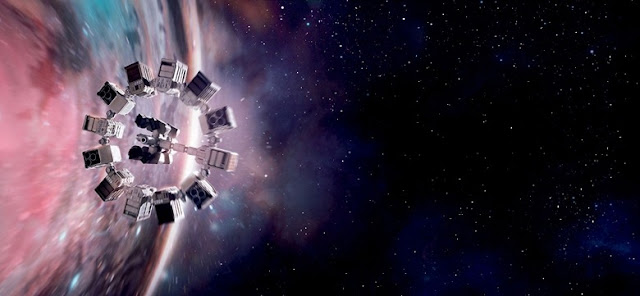<Picture 1 ; the Black Hole from 「Interstellar」>
In the last post, we talked about the Escape Speed. If something travels beside a massive object slower than its escape speed, then it will be sucked into the massive object. Meanwhile if it travels faster than its escape speed, then it will just ignore the gravitation and go along its original route. The Black Hole is extremely massive thing. So, its escape speed is faster than the light's speed. It means that nothing, even the light, can survive when traveling beside a black hole. The black hole is based on the Einstein's general relativity. So, today we're gonna talk about the general relativity and black holes.
1. Einstein's General Relativity; a Light Can Be Bent
<Picture 2 ; Similarity between Acceleration and Gravity>
Suppose that there are two spaceship. One is on the earth and the other one is traveling in the space. If you drop the ball in the spaceship on the earth, then it will simply be fallen to the bottom of it. It’s because of the gravity. If the mass of ball is m, the force which affects the ball will be -mg. (g is gravitational constant.)
Meanwhile, the other spaceship is traveling with a speed g and its direction is upward. Then the force will be also –mg as same as in the first case. There will be no differences between the first case and the second case in the physical views. It is the principle of equivalence which lead einstein to the general relativity.
<Picture 3 ; a Light Can Be Bent>
Einstein thought that if a light pass through the spaceship horizontally, an observer in the spaceship will think that it is bent. It’s because of the spaceship’s movement. While the light pass through, the spaceship moved upward so the observer felt that it is bent.
According to the principle of equivalence, it should be same on the earth. It means that the movement of something, even the light, can be affected by the gravity. Einstein concluded that a massive thing can warp the space and time and it can affect the movement of something. The conclusion of general relativity implied that the light’s movement can be affected by the gravity and many people was skeptical of this idea until Eddington observed the eclipse in the africa.
2. Eddington's Eclipse Observation
<Picture 4 ; Arther Eddington>
Arther Eddington, an english astrophysicist, traveled to the island of Principe near Africa to watch the solar eclipse of 29 may 1919. During the eclipse, he took pictures of the stars in the region around the sun.
<Picture 5 ; Eddington's Eclipse Observation>
According to the theory of general relativity, stars with light rays that passed near the Sun would appear to have been slightly shifted because their light had been curved by its gravitational field. This effect is noticeable only during eclipses, since otherwise the Sun's brightness obscures the affected stars.
His observation published the next year and it confirmed Einstien’s general relativity. The news was reported in newspaper all over the world because it was the conclusive proof of Einstein’s theory.
3. The Black Holes
Now, we know that the gravitational force warp the space and time and it affects the movements surrounding it. According to the escape speed, the more massive it is, the faster its escape speed is. The black hole is extremely massive that its escape speed is faster than light. Because no light can escape, black holes are invisible. Let’s check the black holes short description.
<Picture 6 ; Supermassive Black Holes>
There are three main types of black holes. The black hole’s mass and size determines what kind it is. The smallest ones are known as primordial black holes. Scientists say that this type is as small as a single atom but with the mass of a large mountain.
The most common type of medium-sized black holes is called ‘stellar.’ The mass of a stellar black hole can be up to 20 times greater than that of the sun and can fit inside a ball with a diameter of about 10 miles.
The largest black holes are called ‘supermassive black holes.’ They have masses greater than 1 million suns combined and would fit inside a ball with a diameter about the size of the solar system. Scientific evidence suggests that every large galaxy contains a supermassive black hole at its center.
<Picture 7 ; Stellar Evoultion Chart from NASA>
Then how do black holes form? Primordial black holes are thought to have formed in the early universe, soon after the big bang. Stellar black holes form when the center of a very massive star collapses in upon itself. This collapse also causes a supernova, or an exploding star, that blasts part of the star into space. Lastly, supermassive black holes is considered to form at the same time as the galaxy form. The size of the supermassive black hole is related to the size and mass of the galaxy it is in.
<Picture 8 ; Wormhole>
Do you know that there are wormhole in the black hole leading to the other space? What would happen if we travel into the black hole? Does the whitehole from SF movies really exist? Let’s talk about Traveling through Wormhole in the next post. Thank you for reading it.
Bibiology
https://en.wikipedia.org/wiki/Arthur_Eddington
https://en.wikipedia.org/wiki/Black_hole
http://navercast.naver.com/contents.nhn?rid=20&contents_id=296
http://navercast.naver.com/contents.nhn?rid=116&contents_id=5220
http://www.nasa.gov/audience/forstudents/k-4/stories/nasa-knows/what-is-a-black-hole-k4.html










댓글
댓글 쓰기